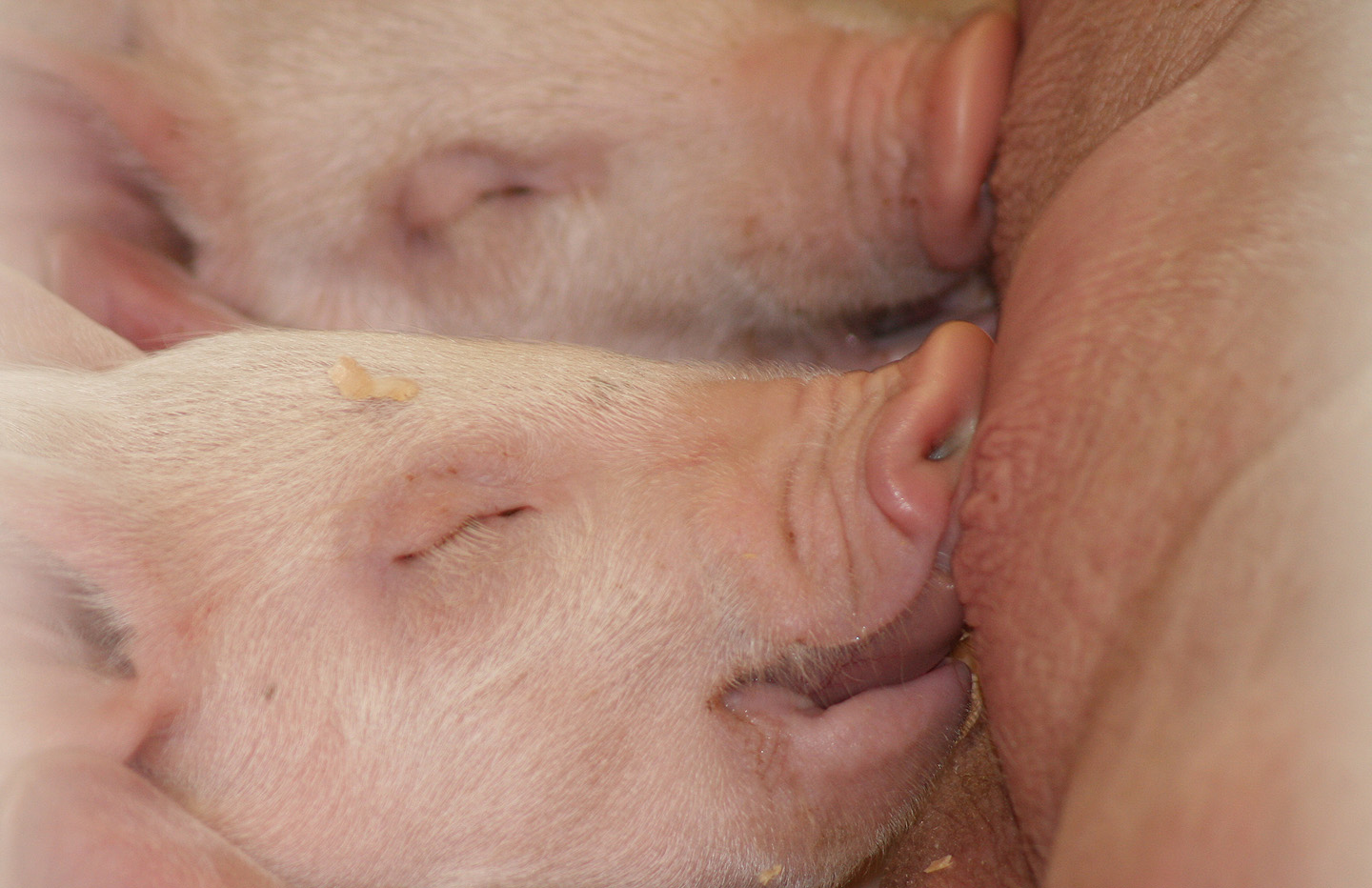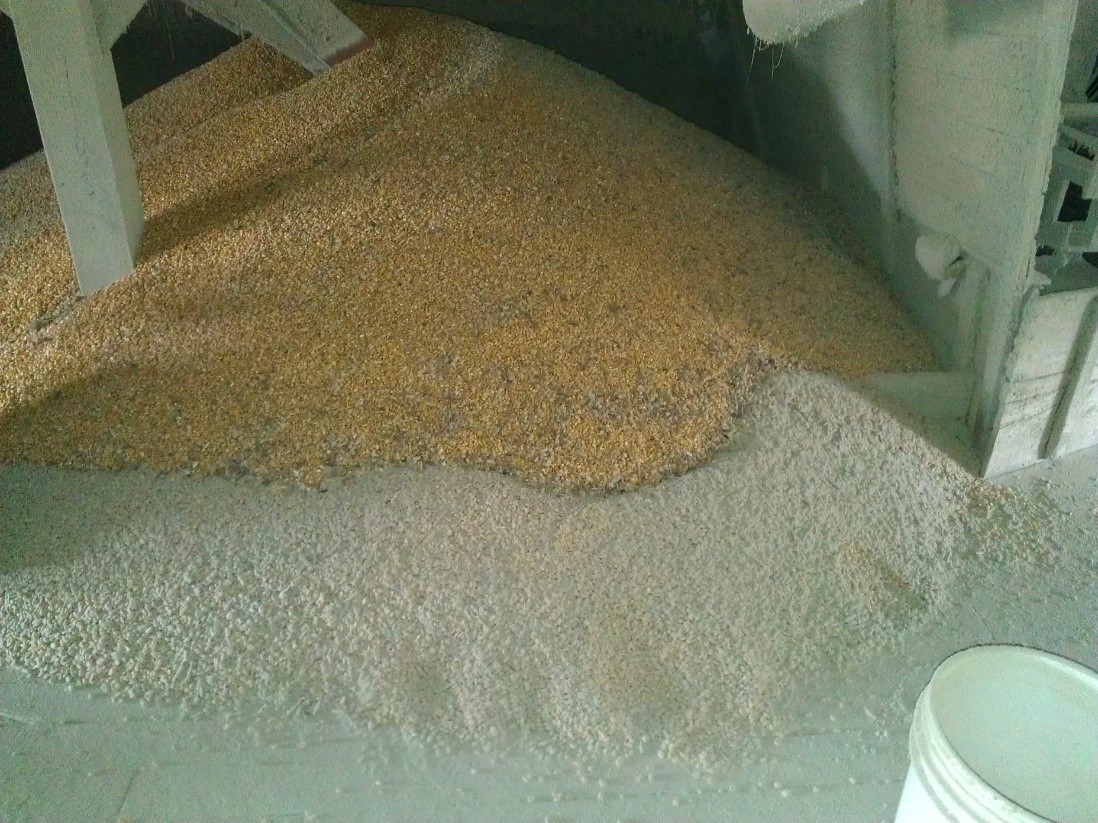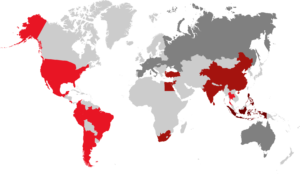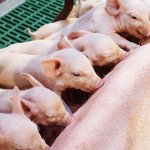By Technical Team, EW Nutrition
As pig production specialists, we understand that our animals are under constant challenge during their life. Challenges can be severe or moderate, correlated to several factors – such as, for instance, stage of production, environment, and so on – but they will always be present. To be successful, we need to understand how to counter these challenges and support the healthy development of our pigs.

Factors for successful pig production
For years we have been increasing our understanding of how to formulate diets to support a healthy intestine through the optimal use of the supplied nutrients. Functional proteins, immune-related amino acids, and fiber are now applied worldwide for improved pig nutrition.
What lies beyond formulation adjustments?
However, pig producers have also realized that these nutritional strategies alone are not always fully efficient in preventing an “irritation” of the immune system and/or in preventing diseases from happening.
Immune nutrition is gaining a strong foothold in pig production, and the body of research and evidence grows richer every year. At the same time, we see genetics continually evolving and bringing production potential to increasingly higher levels. We are also constantly increasing our understanding of the importance of farm and feed management, as well as biosecurity in this process.
Finally, the importance of a stable microflora is now uncontested. Especially around weaning, a stable microflora is necessary to prevent the proliferation of pathogens such as E.coli bacteria. Such pathogens can degrade the lysine (the main amino acid for muscle protein production) we have added to our formulations, rendering it useless.
Single molecules (or additives) are able to support the development of gut microflora, boost its integrity, and therefore help the animals use “traditional nutrients” in a more effective way.
The impact of immune system activation on the performance of pigs
Animal performance is influenced by complex processes, from metabolism to farm biosecurity. Environmental conditions, diet formulation and feed management, and health status, among others, directly affect the amount of the genetic potential that animals can effectively express.
Among these so-called non-genetic variables, health status is one of the most decisive factors for the optimal performance from a given genotype. Due to the occurrence of (sub-) clinical diseases, the inflammatory process can be triggered and may result in a decrease in weight gain and feed efficiency.
Not so long ago, pig producers believed that a maximized immune response would always be ideal for achieving the best production levels. However, after decades spent researching what this “maximized immune response” could mean to our pigs, studies from different parts of the globe proved that an activated immune system could negatively affect animal performance. The perception is nowadays common sense within the global pig production industry.
That understanding led us to increasingly search for production systems that will yield the best conditions for the pigs. This means minimum contact with pathogens, reduced stress factors, and therefore a lower need for an activated immune system.
How immune system stimulation works
The immune system has as main objective to identify the presence of antigens – substances that are not known to the body – and protect the body from these “intruders”. The main players among these substances are bacteria and viruses. However, some proteins can also trigger an immunological reaction. Specific immune cells are responsible for the transfer of information to the other systems of the body so that it can respond adequately. This response from the immune system includes metabolic changes that can affect the demand for nutrients and, therefore, the animals’ growth.
The stimulation of the immune system has three main metabolic consequences:
- behavioral responses
- direct connection with the endocrine system and regulation of the secretions
- release of leukocytes, cytokines, and macrophages
In general, the immune system responds to antigens, releasing cytokines that activate the cellular (phagocytes) and humoral components (antibody), resulting in a decreased feed intake and an increased body temperature/heat production.
When feed formulation is concerned, possibly even more important is to understand that the activation of the immune system leads to a change in the distribution of nutrients. The basal metabolic rate and the use of carbohydrates will have completely different patterns in such an event. For instance, some glucose supplied through the feed follows its course to peripheral tissues; however, part of the glucose is used to support the activated immune system. As a consequence, the energy requirement of the animal increases.
Protein synthesis and amino acid utilization also change during this process. There is a reduction of body protein synthesis and an increased rate of degradation. The nitrogen requirement increases because of the higher synthesis of acute-phase proteins and other immunological cells.
However, increased lysine levels in the diets will not always help the piglets compensate for this shift in the protein metabolism. According to Shurson & Johnston (1998), when the immune system is activated, there is further deamination of amino acids and increased urinary excretion of nitrogen. Therefore we need to understand better which amino acids must be supplied in a challenging situation.
In pigs, the gastrointestinal tract is, to a large extent, responsible for performance. This happens because the gut is the route for absorption of nutrients, but also a reservoir of hundreds of thousands of different microorganisms – including the pathogenic ones.
Understanding Gut Health
Gut health and its meaning have been the topic of several peer-reviewed articles in the last few decades (Adewole et al., 2016, Bischoff, 2011, Celi et al., 2017, Jayaraman and Nyachoti, 2017, Kogut and Arsenault, 2016, Moeser et al., 2017, Pluske, 2013). Despite the valuable body of knowledge accumulated on the topic, a clear and widely-accepted definition is still lacking. Kogut and Arsenault (2016) define it in the title of their paper as “the new paradigm in food animal production”. The authors explain it as the “absence / prevention / avoidance of disease so that the animal is able to perform its physiological functions in order to withstand exogenous and endogenous stressors”.
In a recently published paper, Pluske et al. (2018) add to the above definition that gut health should be considered in a more general context. They describe it “a generalized condition of homeostasis in the GIT, with respect to its overall structure and function”. The authors add to this definition that gut health in pigs can be compromised even when no clinical symptoms of disease can be observed. Every stressful factor can undermine the immune response of pigs and, therefore, the animals’ performance.
All good information on this topic leads us to the conclusion that, without gut balance, livestock cannot perform as expected. Therefore, balance is the objective for which we formulate our pigs’ feed.
Current nutritional strategies for a stable gut microbiota
Feeding: quality of raw materials
The photos included here were taken in the field and show that taking action against this reality is a must for keeping animals healthy.
Much of this action is related to farm management. The most effective way to minimize such situations is to implement a strict control system in the feed production sites, including controlling raw material quality.
Additives can be used to improve the safety of raw materials. As already extensively discussed, everything that goes into the intestine of the animals will affect gut health and performance. Therefore, the potential harmful load of mycotoxins should be taken into account. Besides careful handling at harvest and the proper storage of grains, mycotoxin binders can be applied to further decrease the risk of mycotoxin contamination.


The effect of nutrition on microflora: commercial weaning diet after focusing on gut health
The gut-health-focused formulation of diets must take into account the following essentials:
- decrease of gut pH
- gut wall integrity
- minimization of (pathogenic) microbial growth
- microflora modulation with consequently improved colonization resistance
Gut pH
A lower pH in the stomach slows the passage rate of the feed from the stomach to the small intestine. A longer stay of the feed in the stomach potentially increases the digestion of starch and protein. The secretion of pancreatic juices stimulated by the acidic stomach content will also improve the digestion of feed in the small intestine.
For weaned pigs, it is essential that as little as possible of the substrate will reach the large intestine and be fermented. Pathogens take advantage of undigested feed to proliferate. Lowering these “nutrients” will decrease the risk of bacterial overgrowth.
The same is true where protein sources and their levels are concerned. It is essential to reduce protein content as much as possible and preferably use synthetic (essential) amino acids. The application of such sources of amino acids has been proven long ago, and yet in some cases, it is still not fully utilized. Finally, using highly digestible protein sources should, at this point, be a matter of mere routine.
All these strategies have the same goal: the reduction of undigested substances in the gut. Additionally, the reduction of the protein levels can also decrease the costs of the diets.
Further diet adjustments
Further diet adjustments, such as increasing the sulfur amino acids (SAA) tryptophan and threonine to lysine ratio, must also be considered (Goodband et al., 2014; Sterndale et al., 2017). Although the concept of better balancing tryptophan and threonine are quite clear among nutritionists, SAA are sometimes overestimated. Sulfur amino acids are the major amino acids in proteins related to body maintenance, but not so high in muscle proteins. Therefore, the requirement of SAA must also be approached differently. Unlike lysine, the requirements of SAA tend to be higher in immunologically stimulated animals (Table 1).
| Pig weight (kg)
|
ISA* | SID Lysine (%) | SAA (%) | SAA:Lys |
| 9 | High | 1,34 | 0,64 | 0,48 |
| Low | 1,07 | 0,59 | 0,55 | |
| 14 | High | 1,22 | 0,62 | 0,51 |
| Low | 0,99 | 0,57 | 0,58 |
Table 1. Effect of the immune system activation on the demand for lysine and sulfur amino acids in pigs (Stahly et al., 1998)
*ISA – immune system activation
Vitamins and minerals are classic nutrients to be considered when formulating gut health-related diets. Maybe not so extensive as the amino acids and protein levels, these nutrients have, however, been found to carry benefits in challenging situations. In the past several years, a lot was published on the requirements of pigs facing an activation of the immune system. Stahly et al. (1996) concluded that when the immune system is activated, the phosphorous requirements change.
| Parameters
|
ISA* | |
| High | Low | |
| Feed intake (g/d) | 674 | 833 |
| Weight gain (g/d) | 426 | 566 |
| Available P (%) | 0,45 | 0,65 |
Table 2. Effect of the immune system activation on the performance and phosphorous requirements of pigs (Stahly et al., 1998)
*ISA – immune system activation
Another example is vitamin A. It is involved in the function of macrophages and neutrophils. Vitamin A deficiency decreases the migratory and phagocytic abilities of the immune cells. A lower antibody production is observed in vitamin A deficiency as well. Furthermore, vitamin A is an important factor in mucosal immunity, because this vitamin plays a role in lymphocyte homing in the mucosa (Duriancik et al., 2010).
Phytomolecules: key additives to support gut health
Phytomolecules are currently considered one of the top alternatives to in-feed antibiotics for pigs worldwide. Programs sponsored by the European Union are once more evaluating the effectiveness of these compounds as part of a strategy to produce sustainable pigs with low or no antibiotic use. The EIP-Agri (European Innovation Partnership “Agricultural Productivity and Sustainability”) released a document with suggestions to lower the use of antibiotics in feed by acting in three areas:
- improving pig health and welfare
- changing attitudes and human habits
- finding specific alternatives to antibiotics
Under the last topic, the commission recommends plant-based feed additives to be further examined.
Antibiotics have been used for many years for supporting performance in animal production, especially in critical moments. The mode of action consists of the reduction of pathogen proliferation and inflammation processes in the digestive tract. These (soon-to-be-) banned compounds therefore reduce the activation of the immune system, helping keep pigs healthy through a healthy gastrointestinal tract. As potential alternatives to antibiotic usage, phytomolecules should be able to do the same.
The mode of action of phytomolecules
Antimicrobial
Most phytomolecules used nowadays aim to control the number and type of bacteria in the gut of animals. According to Burt (2004), the antimicrobial activity of phytomolecules is not the result of one specific mode of action, but a combination of effects on different targets of the cell. This includes disruption of the membrane by terpenoids and phenolics, metal chelation by phenols and flavonoids, and protective effects against viral infections for certain alkaloids and coumarins (Cowan, 1999).
Digestion support
The antimicrobial efficacy is one of the most important activities of secondary plant compounds, but it also impacts digestion. Windisch et al. (2008) states that growth-promoting agents decrease immune defense stress during critical situations. They increase the intestinal availability of essential nutrients for absorption, thus promoting the growth of the animal.
Indeed, phytomolecules are a good tool for stabilizing the gut microbiota. But more can be expected when adding this class of additives into your formulation and/or farm operations. Mavromichalis, in his book “Piglet Nutrition Notes – Volume 2”, brings attention to the advantages of using phytomolecules such as capsaicin, which is often related to increased feed intake. Recent research has demonstrated that capsaicin increases the secretion of digestive enzymes that may result in enhanced nutrient digestibility. According to Mavromichalis, this can lead to a better feed conversion rate as more nutrients are available to the animal. Indirectly, this also helps control the general bacterial load in the gut.
Antioxidant support
This results from the polyphenols’ capacity to act as metal-chelators, free radical scavengers, hydrogen donators, and inhibitors of the enzymatic systems responsible for initiating oxidation reaction. Furthermore, they can act as a substrate for free radicals such as superoxide or hydroxyl, or intervene in propagation reactions.
This variety of benefits explains at least partially the high level of interest in this group of additives for pigs under challenging conditions. For the production of effective blends, it is crucial to understand the different modes of action of the phytomolecules and the probable existing synergies. Furthermore, the production technology must be considered. For instance, microencapsulation techniques that prevent losses during feed processing are an important consideration.
Not to be discarded: Biosecurity
The recent outbreak of African Swine Fever focused our attention on something that is sometimes neglected on the farm: biosecurity rules. According to the report “Good Practices For Biosecurity In The Pig Sector” (2010), the three main elements of biosecurity are:
- segregation
- cleaning
- disinfection
In general terms, the following steps must be adopted with the clear goal of reducing the challenges that the pigs are facing.
- Farms must be located far from other farms (regardless of the species) and ideally must be protected with natural (forest/woods) or physical barriers.
- Only one entrance must be used to go into the farm (for both vehicles and people) and a disinfection procedure must be in place, either by an automatized system or by manual application of disinfectants. Equipment disinfection systems must also be in place.
- Workers and any other person that enters the facility should adhere to strict biosecurity measures 24/7. The farms must have a visitors’ book including relevant data on previous visits to farms (regardless of the species).
- Trucks and visitors should not have been in contact with other pigs recently (at least 48 hours previous to the visit).
- Only farm workers are allowed to go into the barns unless special approval is given (followed by strict biosecurity measurements prior to the visit).
- The use of clothing and footwear that are worn only in the pig unit (and certainly not during visits to other pig farms) is recommended.
- No materials (e.g. tools) can be moved from one barn to another barn. People that enter a barn should change footwear and wash their hands with soap for at least 10 seconds.
These simple actions can make a big difference to the performance of the pigs, and as a consequence to the profitability of a swine farm.
Take-home messages
Different formulations and reassessed nutritional level recommendations have been on the radar for a couple of years. It is high time to consider using efficient additives to support the pigs’ gut health. Phytomolecules appear as one of the most prominent tools to reduce pathogenic stress in pig production. Either via feed or water, phytomolecules are proven to reduce bacterial contamination and therefore reduce the need for antibiotic interventions. Furthermore, a more careful look at our daily activities in the farm is crucial. Paying attention to biosecurity and to feed safety should be standard tools to improve performance and the success of pig production operations.
References are available upon request.
*The article was initially published in the PROCEEDINGS OF THE PFQC 2019
















